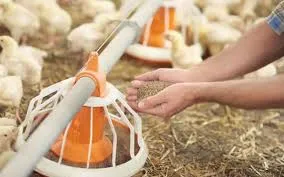
Des . 17, 2024 09:51 Back to list
Rabbit Coccidiosis Outbreak and Its Impact on Cecal Health
Coccidiosis in Rabbits Understanding the Plague of Cecal Infections
Coccidiosis is a major concern for rabbit breeders and pet owners alike, as it can lead to significant health issues and even death in affected animals. This parasitic disease is caused by protozoan parasites of the genus Eimeria, which infect the intestinal tract of rabbits. Among these species, Eimeria magna and Eimeria intestinalis are the most commonly associated with cecal infections, leading to a condition known as cecal coccidiosis. Understanding the causes, symptoms, treatment, and prevention strategies is crucial for maintaining the health and well-being of rabbit populations.
Causes of Cecal Coccidiosis
Cecal coccidiosis is primarily triggered by the ingestion of oocysts (the infective form of the parasite) from contaminated food or water. The life cycle of Eimeria involves multiple stages; when rabbits consume these oocysts, they hatch in the intestine, releasing sporozoites that invade the intestinal lining. The infection can be exacerbated by factors such as overcrowding, poor hygiene, and stress, which can compromise the rabbit's immune system, making them more susceptible to infection.
Rabbits, particularly young ones, are at a higher risk of coccidiosis due to their developing immune systems. Additionally, rabbits that are kept in unsanitary conditions or those that are fed a diet low in fiber are also more prone to this disease. The cecum, a part of the large intestine, is particularly vulnerable because it plays a crucial role in digesting fibrous materials, which are a significant part of a rabbit's diet.
Symptoms of Infection
The symptoms of cecal coccidiosis can vary depending on the severity of the infection. In many cases, infected rabbits may exhibit no signs; however, as the disease progresses, several clinical signs can be observed. Common symptoms include
- Diarrhea This is often watery and may contain mucus or blood, depending on the severity of the infection. - Weight Loss Infected rabbits may lose weight rapidly due to malabsorption of nutrients. - Lethargy Infected rabbits often show a decrease in activity levels and may appear unusually tired or weak. - Ruffled Fur A rabbit's fur may appear unkempt, indicating poor health. - Dehydration Diarrhea can lead to significant fluid loss, resulting in dehydration, which can be life-threatening if not addressed promptly.
If any of these symptoms are observed, it is crucial to consult a veterinarian for proper diagnosis and treatment
.Treatment Options
cecal coccidiosis rabbit plague

The treatment of cecal coccidiosis typically involves the use of anti-coccidial medications such as sulfonamides or other specific drugs aimed at controlling the parasite. Supportive care, including fluid therapy and nutritional support, is also essential, especially for severely dehydrated or malnourished rabbits. Quarantine measures should be implemented to prevent the spread of the infection to healthy rabbits.
In chronic cases, where damage to the intestinal lining is severe, surgical intervention may be necessary. However, prevention remains the most effective strategy against the disease.
Prevention Strategies
Preventing cecal coccidiosis involves several proactive measures
1. Hygiene Maintain cleanliness in rabbit housing. Regularly clean and disinfect living areas, food containers, and water supplies to minimize the risk of contamination. 2. Proper Nutrition Provide a balanced diet rich in fiber, which helps support healthy digestion and immune function. Fresh hay should constitute the majority of a rabbit's diet.
3. Reduce Stress Ensure that rabbits are kept in a calm, low-stress environment. Avoid overcrowding, as this can lead to increased transmission of parasites.
4. Regular Health Checks Routine veterinary check-ups can help catch early signs of infection and ensure overall health.
5. Isolation of New Arrivals New rabbits should be quarantined for at least a few weeks before introduction to prevent potential transmission of infections.
Conclusion
Cecal coccidiosis is a serious disease that can greatly impact rabbit health if not managed properly. By understanding the causes and symptoms of this condition and implementing effective prevention and treatment strategies, rabbit owners can protect their pets from the ravages of this parasitic plague. Through responsible care and management practices, the incidence of coccidiosis can be significantly reduced, ensuring longer, healthier lives for rabbits in both domestic and agricultural settings.
-
Premium Immune Enhancement Products Trusted Manufacturer & Supplier Factory Solutions
NewsJul.04,2025
-
Top Hemoglobinuria Manufacturer & Supplier Reliable Hemoglobinuria Factory Solutions
NewsJun.24,2025
-
Premium Honeysuckle Products - Leading Honeysuckle Manufacturer & Supplier Factory
NewsJun.10,2025
-
Pulmonary Edema Solutions from Leading Manufacturer & Supplier Reliable Factory Price
NewsJun.10,2025
-
Red Eyes - Leading Red Eyes Manufacturer & Supplier, Premium Quality Factory Price
NewsJun.10,2025
-
Broiler Ascites Syndrome Solutions Top Manufacturers
NewsJun.10,2025




